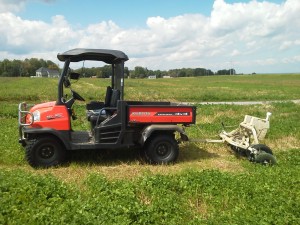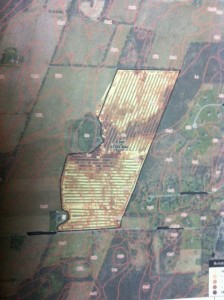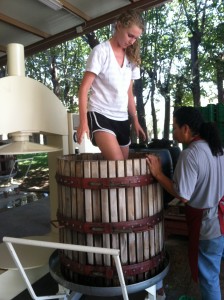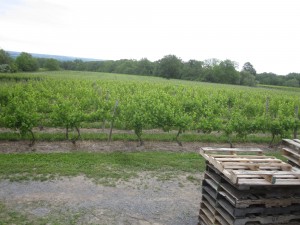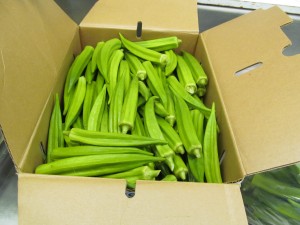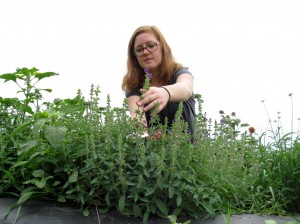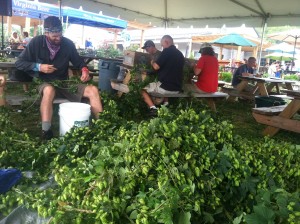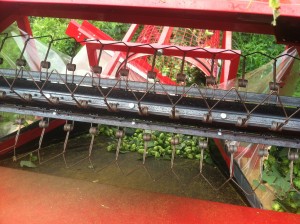During the last week of my internship I had the opportunity to learn about electr0conductivity mapping. In field data is collected with the use of Veris Technologies’ EC machine, which can be pulled behind a truck or a smaller machine such as a Kubota RTV. Collecting data with the EC machine allows a farm to map soil type variation within field very accurately. The EC machine allows a technician to make passes in the field every sixty feet, while data and GPS location is collected every second by the Veris Surveyor and YUMA (GPS unit). The raw data is then sent to the GIS group that analysis the data and then makes a map with five different EC values from low (lightest color) to high (darkest color). After that the maps are then sent back to the service manager that works with the farm to make the final say in how the field is broke up into subsections. A work order is then made to have a field technician soil sample within these subsections so there is a more accurate understanding of the variation within the field. Also with these new maps their is the potential for the grower to begin variable rate application of certain inputs such as fertilizer.
Part Two: People
I left off in my last entry talking about some of the important concerns related to the different portions of businesses that the Hosmers own and run. I wanted to learn more about the challenges of running a vineyard, winery, and tasting room not only because I might want to run one someday, but because it would make understanding the lives of fellow employees easier and hopefully prepare me for future employment in one a similar position.
The Hosmers have been in the wine industry for more than three decades. When it comes to owning a vineyard, I mentioned that it would likely take at least half a decade to start to see the return on invested time and money. That may not seem as long to Ma

My last day at Hosmer was the 27th anniversary party. By the end of the day, enough wine had been poured to cover one of the serving counters with empty wine bottles.
ren and Tunker today as it does to me. However, it seems pretty amazing that Tunker was no more than a few years older than myself at the time he started to plant his vines, and he must have understood that the longevity of his venture from the very beginning.
It may be a long time until I can feel the same pride for my life’s work that the Hosmers do today, but I think many people can understand a small part of a winegrower’s pride. The feeling of a day well spent, of being relied on and coming through, and of the eventual harvest are things that most people can appreciate. Now, I try to imagine the satisfaction that comes from tending vines that have seen four decades and hope to understand that someday.
The second part of Hosmer’s that I discussed was the winery. Because of the scale of production at Hosmer, Aaron Roisen is the only needed full time winemaker. While pondering Aaron’s job, I realized that there is skill in the vintner’s trade, a great deal of scientific understanding, and all the romance you can imagine. Aaron Roisen even told me last year that (and I am paraphrasing here) “Sometimes one of the best parts of being a wine maker is the reaction you get from other people when you tell them what you do”. While there may commonly exist a high esteem for this trade, what Aaron meant was that, like every other trade, there are many, less desirable parts to the job. After a long day of working in the rain, or a morning and afternoon of bottling (which, if not monotonous, is often stressful), or working weekends to stay in pace with harvest, the recognition for your trade by strangers may seem to be the only consoling thing.
I do not, believe for a second that the “romantic aura” that surrounds a vintner is the main reason for many joining the field and sticking with it. Of much more value to a vintners is not the opinion of strangers that would treat the job with uninformed awe, but the praise of respected peers. Above even that (according to Maslow’s hierarchy of needs) might be the self-actualization or fulfillment associated with challenging one’s self and the opportunity to be creative. Even the act of trying to make the same style of wine from year to year is a difficult task as harvest brings different fruit each year. Aaron told me that creative freedom is a very important part of his wine-making career earlier this summer, and I believe it. In my classes and experiments over the last few years, learning and making new creations have been endlessly engaging. Unfortunately, wines are not to customers what they are to the people who want to buy it. I learned that it is the job of the marketing and distribution to essentially create the image and sell the wine.
This overarching responsibility (to create value to the product and assure the sale of it) holds as much creativity and variation in everyday work. All employees needed to create an environment were customers want to buy wine, while individuals like Katie worked on the website and redesign the logo. Others like Maren, Ginny, and David keep up with all the required records, and they all have the responsibility to manage themselves in an effective way.
Coming into the tasting room, I was less prepared by my school work than the other areas of the company. However, unlike working in the vineyard and the winery, I got the opportunity to have the same job and responsibilities that any tasting room worker had. As a result, I feel like I learned a great deal while working with my friends in the tasting room and everywhere else at Hosmers. Thanks guys for giving me an awesome summer.
Harvest and a Reluctant Goodbye
I am happy to say harvest has began! We are just starting to pick the White varieties and the reds for rosé. They are maturing quite quickly now that the heat has really come on. The nights don’t cool down much like they do in California and I think this makes them ripen faster. An important job during harvest season is to test the maturity of the grapes in order to know when to harvest which parcels. To do this we take Berry samples from all 20 parcels. We bring them back to the lab and count out 300 of each bag. We weigh the 300 berries before squishing them into a pulp. The juice is then filtered from the pulp and seeds. The sugar content is measured with a density measure. The more dense the juice, the more sugar content the juice has. Then we measure total acidity and pH. The data is recorded and compared to last year’s data from the same exact date. It was very interesting because this year the grapes are considerably less mature on this date. The sugars are lower and This is probably because the summer has been milder and with more rain. Seed samples are also taken from the grape crush to analyze their maturity. Looking at all of the little labeled piles of seeds from different varieties really shows the difference between them. The red varieties had larger greener seeds that the White varieties. It is typical for whites to ripen earlier and this was clear from the more shriveled and darker Brown seeds. In addition we tasted the seeds and crunched them up in our mouths. The acidity of the Green seeds was much higher than the drier more Brown seeds. The berry samples and tests are done once each week to study the maturation and to know when to expect to harvest. Whites will likely be finished by the end of August and reds will begin in mid September through October.
Nuria sorting seeds
The harvesting system is much different than what I am used to. At home a crew comes in to harvest and they are paid per bin they pick. The workers run quickly up and down the rows to dump the grapes at the tractor. Here in Spain the crew is paid hourly which changes the system completely. There is much less rushing and they day in general is more relaxed. In the morning the bins are placed in the rows so they are all ready to go. The crew comes in and picks into the bins which are then picked up by the tractor.
When the grapes are brought to the winery they are immediately crushed. There are 2 large presses that are up high so that gravity can help us and carry the juice to the tanks below. A couple of times we used the small hydraulic press for small batches of grapes. This was much for fun for me because I got to climb into the press and stomp the grapes, “I Love Lucy”- style, as they loaded it up. The juice goes directly into temperature-controlled tanks to wait for fermentation. The first tank took about 3 or 4 days to start. You can tell very easily when it starts because the top gets covered in a layer of white sparkly foam. It’s very pretty.
Harvest is still continuing but unfortunately I had to come back home. School starts soon so I won’t be able to stay for the harvest of the reds. I pretty bummed but that just means I will have to come back to Spain one day! I really had a fabulous time here and will never forget the hospitality that Casa Sicilia showed me. They welcomed me as one of the family and I am so happy to know that I will always have a home here in Novelda. It is hard to say adios but this semester is looking promising. I have wine lab in the shiny new Stocking Hall winery and labs!
I can’t sign off without a little shoutout to my friends in Novelda and my dear Spanglish group. I call them the coffee clan because we met for coffee almost every afternoon, and then filled every weekend with lots of adventures. They helped me so much with learning Spanish and really made my time unforgettable. I dearly hope that one day one of them will show up on my doorstep to visit back in the states. “Spanglish” was also filled with unforgettable people, Spanish and English alike. We got together twice a week and had a great time practicing our languages and laughing…a lot. I can’t wait for the day when one of them calls me in the U.S so I can give back some of the hospitality they showed me.
Hasta luego España, nunca te olvidaré.
Ciao! -Brooke
Soil Sampling and PSNT
For about the last two weeks or so growers have been harvesting their wheat crop, which gives ACS the opportunity to start soil sampling. Each field that is sample usually has a couple samples to be pulled. A sample is pulled from each section of the field and these section can be broken up topographically, by soil type, or by the electro-conductivity mapping that was done previously to sampling. The procedure for soil sampling is pretty straight forward and the tools we use include soil probe, screw driver, sampling boxes or bags depending on work order, ATV to get around the field, and a GPS unit if necessary. Also on the soil probe there are markings at six, eight, and twelve inches because it is important to be fairly accurate with your depth. When pulling a regular soil sampling it is important to keep your depth between six and eight inches so having the markings on the probe really helps. When actually pulling the samples in each section
it takes eight to ten probes to fill a small cardboard box that goes to Dairy One for soil analysis and when we are sending a sample to Spectrum it takes five to six probes to fill those bags properly. When pulling the samples I usually fallow a W or M pattern on the ATV and it is important to avoid wet spots and we also try not to sample in the headlands because they can both alter the sample. Earlier in the summer I also had the opportunity to pull some PSNTs for a couple farms. These are very similar to soils samples but it is important to pull the samples to a depth of twelve inches so that you can determine the full amount of nitrogen available in the soil. These PSNTs are usually pulled around the time when corn has reached the V5 stage just before farms begin to side dress. When pulling the samples you also want to make sure that you avoid taking the sample close to the corn because you could hit the strip of fertilizer they put down while planting.
Part One: Business Entities
My final weeks at Hosmer Winery went by swiftly. In these last couple of weeks I worked in the tasting room with my fellow employees. As the days seemed to pass by more quickly, I began to consider the organization from two stand points: the business and the people that made it possible. This blog entry touches on the monetary considerations of Hosmer’s operation and the next entry focuses on the people that seek work within the whole. It is important to consider the businesses and the people who make a living in each to reflect on my coming career goals.
I guess the most appropriate way of starting is in the vineyard. Known legally as Patrician Verona Inc, this was the oldest and, can be considered a foundation for the two other business entities found at Hosmer. The vineyard was created in the late 70s when Tunker had returned home from school. A recent graduate of the Cornell pomology program (unfortunately, the Viticulture program was not around back then), Cameron planted some of the first Cabernet Franc and Riesling vines, on Cayuga Lake. The age that vines grow often determine how healthy and productive they are, the older the better in some sense, leading to increased quality ingredients in the wine and a major marketing advantage over the years.
Back then, as it remains today, this was no easy feat. To start a vineyard, it took tens of thousands of dollars in preparation, construction materials, and a large amount of labor to start with just a few acres. Some of the costs include leveling and prepare the soil, installing tile drainage, purchasing and planting the one-year old vines, and over the next couple of years, building a trellis system and caring for the vines. Gerald White, the Emeritus faculty member at Cornell has a fantastic article about the costs of establishing a vineyard (http://dev.senecacountycce.org/wp-content/uploads/2013/06/Cost-to-Establish-Produce-Vinifera-Grapes.pdf).
The real kicker of it is that, despite investing much time and energy into the newly planted vines, the Hosmers could only expect to have a harvest three years after they had first planted the vines and only turning a profit a couple of years later. According to several estimates on the subject, it will typically take more than 7 years to get back your investment of a few acres of vineyard with interest. It may have taken many years and many loans to get the vineyard up and running, but Hosmer set himself up perfectly for the next business, a winery. With a decade of establishing a name for great fruit quality and management, building a good line of credit, and having a reliable supply of high quality grapes every year, Hosmer couldn’t have been in a better place to start a winery.
Regardless, opening a winery is not without significant investment in equipment and time. While equipment and ingredients and storage area are just the beginning of the monetary investment before beginning, nearly a year is typically required to create and age many marketable wines. While much initial investment in equipment is required, the issue of cash flow is essential even once a winery is established. The seasonality of wineries means that there are often large purchases of items like grapes, bottles, and additives. Then, there is the issue of selling the wine to make the whole process even worth investment.

Purchasing wine bottles is quite the cash flow issue to tackle. Each stack of 100 cases costs $5,000.
Today the sales, distribution, and overall marketing of Hosmer’s wines are done about half by Southern Wine and Spirits Distributors and half by the Hosmer tasting room. Southern Wine allows Hosmer to sell much more wine and functions to spread Hosmer’s image and reputation further than it might have gone otherwise. Meanwhile, Hosmer’s own tasting room serves to connect customers to the region, the farm, and the family that makes and, essentially is, the Hosmer brand. A tasting room holds a place for loyal customers to come, but works harder to create loyalty within its customer base. While Hosmer sells its finished wine to its distributor, it is at a lower price than at the tasting room, reducing total possible revenue but simultaneously reducing the cost of sales. The tasting room allows for a higher price of wine but incurs steeper costs, especially for employment which can easily make up more than one third of the costs in tasting rooms around the finger lakes. As a result, the profits per unit of wine may be higher by selling through either the distributor or the tasting room. However, the business as a whole makes up from the “potential lost profits” by diversifying potential sales
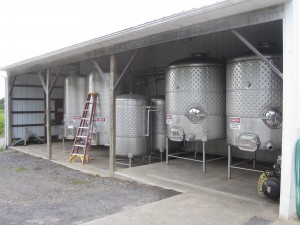
Wine can sit and age for months or years, but if it does not get sold on time at a certain price, all the efforts that went into it are without reward. This is one of the risks distributors minimize for a winery.
avenues and customer touch points.
Having the three business entities (vineyard, winery, and tasting room/distribution) has, in essence decreased the risks of of each separate entity and created a synergy(and I only use this word as it is strictly defines and not to sound like the stereotype of a motivational speaker). It is interesting, however, that many of the benefits of this “more than the sum of its parts” model is created by customer perception. If people truly believed that terrior or any permutation of local favoritism translated to a better experience, then they would pay less for the wine. If the value of the wine and the grapes depended less on locality and reliability, then some of the monetary benefits of Hosmer’s business model would fade and it might be more desirable to have only one of the three business sections.Luckily, there is always more than monetary considerations when running a winery as a business. Luckily, happiness, comfort, and general human considerations are the real reasons why a business such as Hosmer exists as it is.
Hydroponic Problems
Although hydroponic lettuce production has its benefits, it is not a care free system. Even if the nutritional and environmental demands of a plant are met, problems will occur without fail. It can be noted that most, if not all, of these issues are preventable with the proper care and management. Here are some of the issues I dealt with throughout my internship:
Responses to Overcrowding (Shade Avoidance)
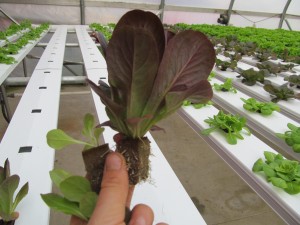
Right plant shading out adjacent plant. The left plant will not have enough time to catch up developmentally and isn’t worth planting, hence, a loss in profit both for the cost of the wasted seed and the loss of a finished lettuce plant.
Plants are sensitive life forms. They have evolved to elicit responses due to the slightest change in environment. Plants are always reaching for the perfect amount of sunlight. Too little sunlight equates to less energy capture and over a prolonged time, death or delayed life cycles. When the lettuce seeds are planted in a foam tray, it’s a race for the seedlings to germinate and capture light. As the plants begin growing, they send out leaves to capture the sunlight. As the plant enlarges, it becomes aware of surrounding plants due to the difference in light quality (far red to red ratios). The plants will sense other plants are shading them out (a larger far red quantity) and therefore bolt up. Over time, they will begin shading out other plants.
Had the lettuce plugs been planted earlier on before this response was so extreme (possibly two weeks earlier), both plants would develop into gorgeous, phenomenal looking bundles of lettuce. It could be noted that although the second plant isn’t used, it may still be able to be planted into another batch of lettuce with proper planning and management.
“Twinning”
Lettuce seeds are quite small, even when covered with different fungicides, chemicals or packaged with nutrients. Be it human error or carelessness, two seeds can be placed, unintentionally, in one foam plug. Both seeds will germinate and immediately begin competing for light, nutrients and water. Many times, one plant will survive, yet, that is not always the case. If the person planting the lettuce does not notice two plants in one plug during planting (or any time before extreme physical changes occur due to the second plant), a “twinning” effect will take place.

Twinning red oakleaf lettuce plants. From this view (looking at one plant), it’s easy to see the dramatic height difference between that and the single plants per plug.
Although it may seem ideal to grow two plants in one plug as a customer, it creates havoc as a grower. This plug will break uniformity in the crop. Although many customers may see this as a plus (two plants for the price of one!), it also may create an unappetizing look for the rest of the crop. Thirdly, these two plants will shade out other plants as the day progresses. Fourthly and finally, this plug will need twice the nutrients and water to grow, which means a slightly elevated cost.
Tip Burn
Greenhouse growing allows more control over environmental conditions. For example, torrential rain was a huge problem during my internship this summer. With silty fields, one heavy rain could equal a loss of thousands of dollars, time and wasted labor. This isn’t a problem in a greenhouse, of course. Yet, a grower can’t have everything: tip burn occurs. The plant will get too much light and oxidize, hence the brown colored burn. Although the burned areas can be pinched off, the uniformity of the crop will be lost.
To prevent this problem, a partial shade can be used to reduce the sunlight. Or, more light tolerable varieties could be utilized.
Root Burn

Root burn on Green Bibb lettuce. Notice the black roots around the edge, the brown roots and the beige roots located close to the center of the plant.
A nice way to determine the last possible moment to harvest a crop completely is to look for root burn. Healthy hydroponic roots will be a white, ivory color. The roots of dying plants (or stressed plants) will be a beige, brown or black color. If there is a deficit of water, which would indicate that the plant is too large to be maintained by the current amount of nutrients and water, the roots will begin to brown before the plant’s leaves show any signs of damage. So, by pulling up a few random plants (one closer to the tube, one in the middle of the channel, one closer to the end of the channel), it can be determined when to pull the rest of the plants.
When we processed lettuce, we would snip off the main portion of roots and leave a roughly 1/2 inch of roots still on the plug. Consumers would not see the root burn and would buy the plants. Had we left the root burn on, it is possible that the consumer would not purchase the plant because it did not look “perfect,” although they do not consume the roots anyways. The 1/2 inch of roots allow the plant to take up water. Given the delicate nature of lettuce, an hour of heat can create a wilting plant.
Okra
Towards the end of my internship, I began working with Okra. Having no prior experience with okra, both eating or growing, I was quite excited to “meet” a new plant! I was lucky enough to have about sixty plants to work with. Twice a week, I harvested okra in the mornings right after all the dew evaporated.
Okra, Abelmoschus esculentus, is a heat loving southern staple crop. Okra is also synonymous with Ladies Fingers and gumbo. This plant does not tolerate frost or cold weather and must be planted after the last frost. Plants should have a roughly fifteen inch spacing and should not be transplanted.
Okra seed pods are actually what gets harvested. The plant will grow to a mature size and begin flowering. The flowers are actually in the hibiscus or mallow family. The flower themselves were a light yellow color with a striking burgundy bulls eye. After the flower is fertilized, the seed pod begins forming. We harvested seed pods roughly two inches or longer. Many times, we would get seed pods that were the size of bananas as opposed to the size of Jalapeno peppers.
Initially, I would daintily move the leaves of okra to find the seed pods. Yet, I found this to be inefficient because the green pods blend in with the green stems and foliage quite well. So, I would move the leaves and stems around with more gusto. I could harvest anywhere from a half peck of okra to two bushels of okra depending on the environmental conditions.
Another challenge with okra was dealing with the “hairs” on it. As I would move around the leaves, the trichomes would irritate my skin. If any okra breeder reads this blog, I would encourage breeding a variety with less trichomes or even better, a smooth plant! My final challenge with this southern beauty was keeping hold of the pods. Okra has a slimy texture when cooked and a slick texture when picked. By the tenth plant, my hands would be quite slick themselves!
I did try some raw, uncooked okra. Its texture was unique compared to all other plants, but reminded me of eating sea weed. I can understand why many people say the taste is acquired! Some customers couldn’t get enough okra while others were curious, but not adventurous with their taste buds. A fellow employee mentioned that in Mexico, okra is ground up and used like a coffee. This plant was memorable.
Flower Selection & Arrangments
To many people, flowers are fickle, useless, short lived and much too expensive. They view flower picking as a quick, thoughtless, mindless process. Arranging flowers is “easy” because “you just make it look pretty.” Yet, there’s so much more to flowers than meets the eye. Gomphrena, sunflowers, cornflower, strawflower, Scabiosa, snapdragons, and zinnias (including the Zowie hybrid, Senora and Exquisite cultivars) were some of the flowers in the cutting garden.
Flowers are usually picked in the morning. This is because the plant will not have a huge water deficit (as compared to afternoon or high sun) and are not wilting. As I went through the rows of flowers, I would remove any flowers that were dead, losing petals or in the seeding stage. By deadheading flowers, the plant will continue to send up blooms. Hence, one zinnia plant can be trained to flower all summer long.
Generally, I made a few yellow sunflower bouquets, a mixed sunflower bouquet, a pink or red zinnia bouquet, a snapdragon bouquet and a multicolored (yellow, green, red, orange, pink, yellow or mixed) zinnia bouquet. After that, I would mix together flowers to create different types of arrangements.
I made bouquets that used flowers with petal colors that would be opposite on the color wheel or having a contrasting scheme. For example, I would pair a yellow flower with a purple one, a white with a black or a red flower with a green one. This enhances each color. I would also do analogous scheme colored bouquets with nice cool blues and purples or pinks, reds and oranges. This creates a more uniform appearance, but allows each flower to be unique. The mixed color zinnia bouquet would be considered a polychromatic bouquet. Some bouquets were made to be viewed as a centerpiece while others were meant to be viewed facing a certain direction.
After cutting flowers and tying the bouquets, the flowers were placed in water and then re-cut. This keeps the arrangement lasting longer because the water will conduct up the stem. Had the flowers only been cut in air and not in water, the stem would have sucked up an air bubble, preventing the uptake of water. If water cannot be transported, the flower will begin dying sooner. The bouquets were then bagged, filled with water, tied and set in a half bushel basket for sale.
Many studies indicate the benefit of plants, nature and flowers. In particular, hospital patients with a view of trees, grass or flowers recovered faster than patients with views of concrete or brick walls. In World War II, there are letters in which soldiers asked family members to send a favorite flower or vegetable to grow in their fox holes. Secondly, flowers have dominated history. There’s the War of the Roses, the Tulip Craze, the poppies of In Flanders Fields, or the inclusion of flowers in art. Thirdly, flowers have been associated with health and death, sadness and happiness. Flowers are bursting in weddings, proms, homecomings and funerals. Many religious traditions include flowers. Flowers, although feeble, flimsy or whimsical have a place and purpose in history.
Even if one doesn’t care about flowers, they still can appreciate them. To eat that delicious orange, make that strawberry jam, or slice up that pepper, a flower needed fertilized. For that plant to flower, the leaves needed a signal from the day length. For those leaves to be present, a stem needed constructed. The stem couldn’t be constructed if it wasn’t anchored by roots. The roots would not occur if a small seedling didn’t germinate. Furthermore, that seedling came from a fertilized flower. The point merely is that to look at one specific area or aspect of the plant, the entire plant needs scrutinized and appreciated.
Spreading beneficial mites
Pest control is always on the mind of the grower and farmer. Pests, from the frolicking deer to the smallest of mites, create financial, ethical and ecological concerns. There’s a balance between managing an ecologically sensitive farm to minimizing financial loss. On top of that, farmers need to demonstrate an ethical concern about safety for them, their employees, the environment and most vitally, the consumer. Taking all of this into consideration, the utilization of beneficial insects (or bio-control) seems ideal.
Prior to spreading beneficials, there are a few steps. Firstly, identifying a problem or a lack of one is essential. With new varieties of plants comes different appearances at different ages. Imagine spending hundreds (or more) of dollars only to find out that a slight difference in appearance is occurring, not a detrimental problem. Secondly, the problem needs identified as being due to pests, diseases, the environment or nutrition. Thirdly, a treatment plan should be utilized. Fourthly, a prevention plan needs set into place. Although the initial goal is to save the crop, the long term goal is to prevent this problem from reoccurring.
On cucumbers and beans, a white splotchy pattern will occur with thrip infestations. It will look like jeans when bleach is splattered on them. Thrips are slender insects with fringed, toothy wings. These pesky bugs will pierce a plant and suck the contents out of the cell. Basically, imagine slurping a smoothie (the cell contents) out of a cup (the cell of the plant). Although thrips have a hard time flying, the will migrate around the greenhouse quite well due to the fan. We spread predatory mites (the beneficials) to control a variety of thrip larva and hatching eggs. Luckily for us, a few days after the infestation was spotted, we had a cloudy, rainy day with 55-65 degree temperatures to spread the mites.
To spread the mites, I would walk down the rows sprinkling a teaspoon of what looked like sawdust on the leaves of the plants. It was important to spread on lower leaves and leaves higher up on the stem to get a nice coverage of the plants. It was also quite tricky to reach some of the taller leaves on cucumber plants. After I finished spreading the mites, I left the empty bottles in the middle of the rows in case any mites were still inside.
To help prevent huge infestations, companion planting was utilized (intentionally or not). Basically, instead of having a greenhouse monoculture, most greenhouses had a mix of plant species and families. In one house, lettuce, tomatoes and herbs were placed together while radishes, beans, cucumbers and basil were placed together in another. This creates a more diverse ecosystem that will attract a variety of pollinators, including many beneficial parasitic wasps.
Let me hop picking begin!
At the beginning of August most of the hop plants are finished and ready to be harvested. Hops start forming on the plant in July after the plants “bur-out”. Hops are cones bright green cones that hang from the vines. If you break one open you can see a yellow powder called lupin. Once the hop cones have matured and dried out a little they are ready to be picked and harvested.
This is and can be a very time consuming process. For this reason, most hopyards host hop harvest events to help attract volunteers. Two of the hop farms I worked on, Whipple Creek Farms and Blue Mountain Brewery had these types of events. Marketing is crucial in getting the word out about these festivities and attracting volunteers. Social Media sites like Facebook are vital through this process. Posters, newspaper articles, and radio announcements are also useful and used. One way to attract potential volunteers while helping support other local artists and businesses is by adding additional activities and events. Whipple Creek Farms hop harvest was sponsored and supported by Devil’s Backbone. During this harvest festival they also included face painting, live music, local food and a new beer release.
Due to timing and a previous commitment I had to leave Virginia before the hop harvest at Whipple Creek Farms. However, I was able to attend and work at Blue Mountain Brewery’s. We arrived to Blue Mountain at around 9:30 am to start cutting down the hop plants. We did this using a ladder and the cart we used for stringing. We would then either bring the plants to tents where volunteers would be sitting at picking from 11am- closing, or cut the vines into 4 foot sections to be fed into the hop picking machine. At Blue Mountain Brewery’s festival the volunteers were promised a free lunch if they picked for 2 or more hours. This helped ensure that people were picking and encouraged them to stay for a couple hours. Volunteers sat and picked under tents while eating food, drinking beer and listening to local and live music.
The hop specialist, Stan Driver, purchased the hop picker last year. It is a fairly new piece of machinery and unfortunately has a lot of kinks that still need to be worked out. You insert the hop plants and twirl it around as these teeth strip leaves and the cones. These then tumble down into this cylinder and come down on a conveyer belt. Harvesting hops is an extremely labor intensive process. Hand picking takes hours, days and weeks. The hop harvester greatly reduces this and is extremely beneficial.
Although I sadly had to miss the Whipple Creek Farm and Devils Backbone hop harvest, I was fortunate enough to participate in another. Blue Mountain Brewery harvested about 25 trash bags full of hops and Whipple Creek Farms harvested about 800 pounds. Some of the hops from each hopyard will be dried and stored. Others will be used to make a “wet” hops beer.
I got to see how important marketing is and how many hop farms wouldn’t be able to harvest their yields without the help of volunteers. It was a great experience to work with the hop harvester, pick by hand and I got to meet a lot of great people.

